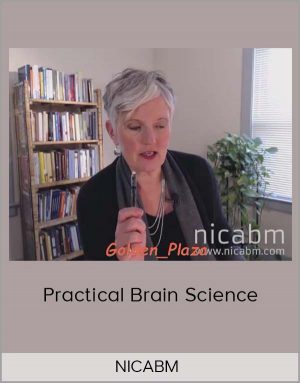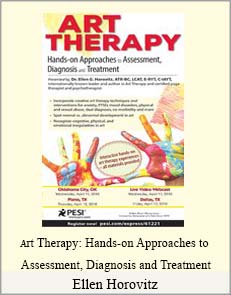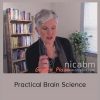NICABM – Practical Brain Science
$65.00$397.00 (-84%)
The 3 Kinds of Attention that Every Good Leader Needs to Know So That They Can Encourage People to Create Lasting Change
NICABM – Practical Brain Science

Check it out: NICABM – Practical Brain Science
If the Brain Can Change, Our Patients’
Lives Can Change.
Here’s How to Harness the Power of Neuroplasticity to
Enable These Changes to Happen
In the hands of a skilled practitioner, brain science can empower your clients to transform their lives
And in nearly every clinical circumstance, no matter your objectives, a more fit brain can benefit almost any patient.
It can help them think more clearly, develop greater focus, and manage reactive emotions.
But there’s so much information (with more coming out every day), and few of us are neuroscientists.
So – what if you could cut through all of the theory and the thousands of research articles to quickly identify specific interventions that could rewire your patients’ brains and change their lives?
In this program we’ll boil down the latest developments to clear, simple principles you can use after just minutes of study.I’ll bring in 6 of my colleagues to show you specific ways you can use neuroplasticity to bring about lasting change in your clients’ lives.
If we want to help them think more clearly, achieve greater focus, manage reactive emotions, and help them experience so many other benefits, showing patients how to change and strengthen their brains may be the first and most crucial step.
Get 6 Webinars with Fresh Ideas and Interventions That Can Change Your Clients’ Lives:
Strengthening Focus: Why Concentration Can Make the Brain More Powerful
Daniel Goleman, PhD
Author of Focus: The Hidden Driver of Excellence
How to Help Your Clients Avoid the Number One “Distractor Circuit” in the Brain that Derails Concentration
The Link between Mindfulness and Cognitive Control (and How to Strengthen It)
What the Brain Is Actually Doing When People Think They’re Multitasking
Maintaining Concentration Amid Distractions: 4 Strategies for Better Focus
The 3 Kinds of Attention that Every Good Leader Needs to Know So That They Can Encourage People to Create Lasting Change
The Brain in Love: The Neurobiology of Romance
Helen Fisher, PhD
Author of Why Him? Why Her?: How to Find and Keep Lasting Love
The Similarity between Romantic Love and Addiction
Why Novelty Can Help People Fall in Love Again after Rejection
Rejection and the Brain: What Brain Scans Reveal about Healing after a Break-Up and How to Use This to Help Patients Cope with Loss
How to Increase Oxytocin Naturally and Help Your Clients Form Deeper Attachment Bonds with their Partners
What’s Happening in the Brain at Different Stages of Love
Tools to Break Free from Destructive Romantic Attachments
Epigenetics: What Really Controls Genes and Why Your Patients Don’t Have to Be Victims of Their DNA
Bruce Lipton, PhD
Author of The Biology of Belief: Unleashing the Power of Consciousness, Matter, & Miracles
How Fear and Negativity Play a Role in Genetics and Why It’s so Important for Healing
How Experiences Affect Cells, DNA, and the Brain’s Development
Why Genes Do What They Do: From Experience, to Brain, to Biology
The Brain during the First 7 Years of Life
<liProgramming the Brain In Utero: Why “Emotional Chemistry” Is Important to Development
The Neurobiology of the Adolescent Brain: Why Understanding the Young Adult Brain Can Help Practitioners Better Serve Patients of All Ages
Daniel Siegel, MD
Executive Director of the Mindsight Institute, Co-Director of UCLA’s Mindful Awareness Research Center, author of Brainstorm: The Power and Purpose of the Teenage Brain
Why Adolescents May Be the Most Creative and Courageous Individuals in Our Human Family
The Fundamental Change in the Brain that May Be Behind Risky Adolescent Behavior
An Adult’s Limbic System and Brain Stem Work Together to Help Them Get Motivated, but a Teenager’s Brain Is Different – Why Knowing That Is Important for Treatment
Why Certain Psychiatric Disorders Like Schizophrenia, Bipolar Disorder, and Addiction Often Surface during Adolescence
Happiness and Neuroplasticity: Simple Strategies That Can Help Patients Rewire Their Brain for a More Rewarding and Fulfilling Life
Rick Hanson, PhD
Author of Hardwiring Happiness: The New Brain Science of Contentment, Calm, and Confidence
How to Use Neuroplasticity to Transform a Reactive, Negative Brain into a Responsive, Productive One
The Importance of Novelty for Neuroplasticity: Why New Experiences Have Such a Transformative Effect on Your Patients’ Brains
The 5 Factors that Help Learning Take Hold and How They Promote Neuroplasticity
How to Turn Positive Experiences into Lasting Brain Change
How to Teach Your Patients to Rewire Their Brain For More Positive Experiences
Food, Hormones, and the Brain: Essential Ways to Balance the Brain for Optimal Health
Daniel Amen, MD
Medical Director of Amen Clinics, Inc., New York Times bestselling author of Unleash the Power of the Female Brain
Hormones and How They Can Strengthen the Nervous System
What Sugar Does to the Brain and How It Can Harm a Person’s Sex Life
The 5 Pre-wired Strengths of the Female Brain
The “Worry Curve” and Why Some Anxiety May Be Essential to Wellness
Progesterone: The Brain’s “Natural Valium” and Why It Is So Important for Easing Anxiety
Register Here for Only $397
and get the video, audio, transcript, TalkBack, Next Week
in Your Practice, and QuickStart Guide



















